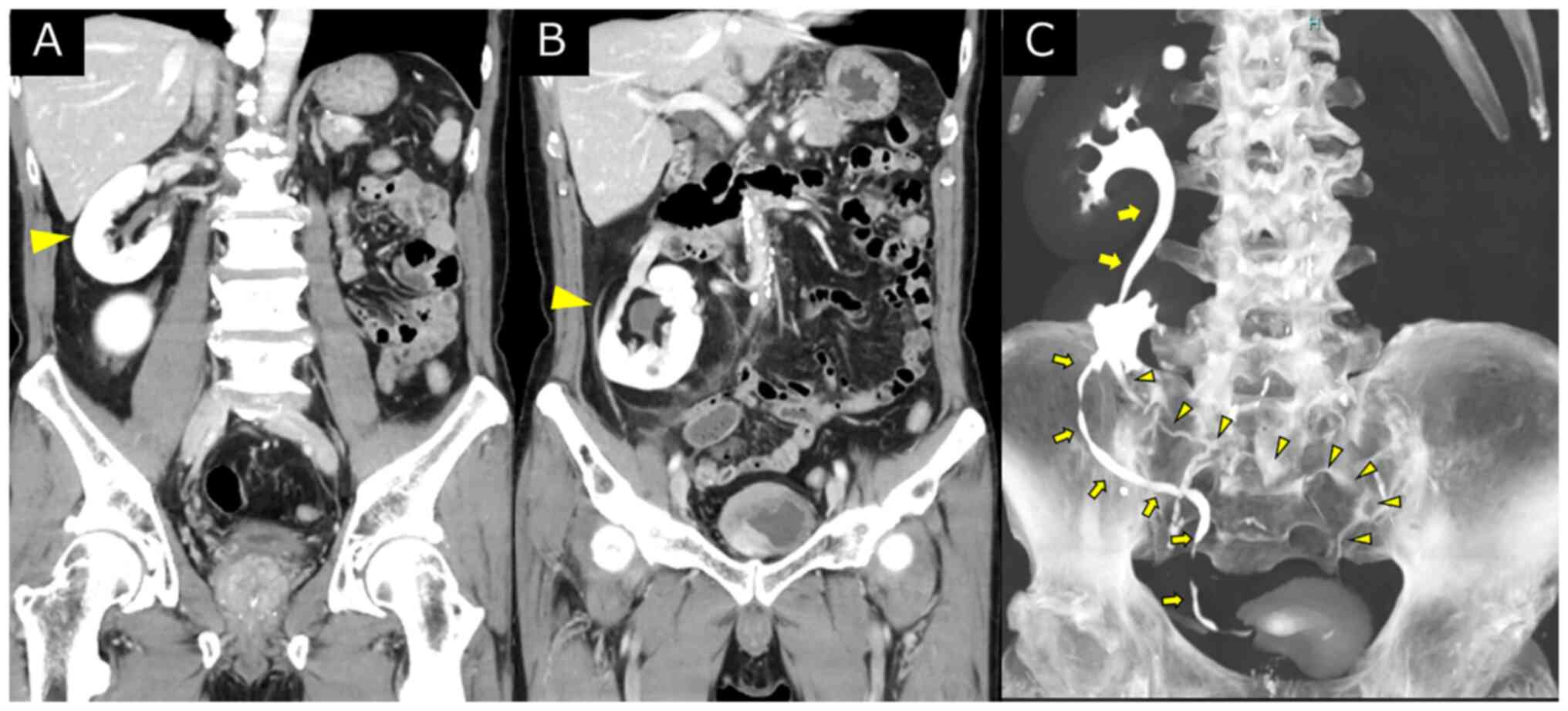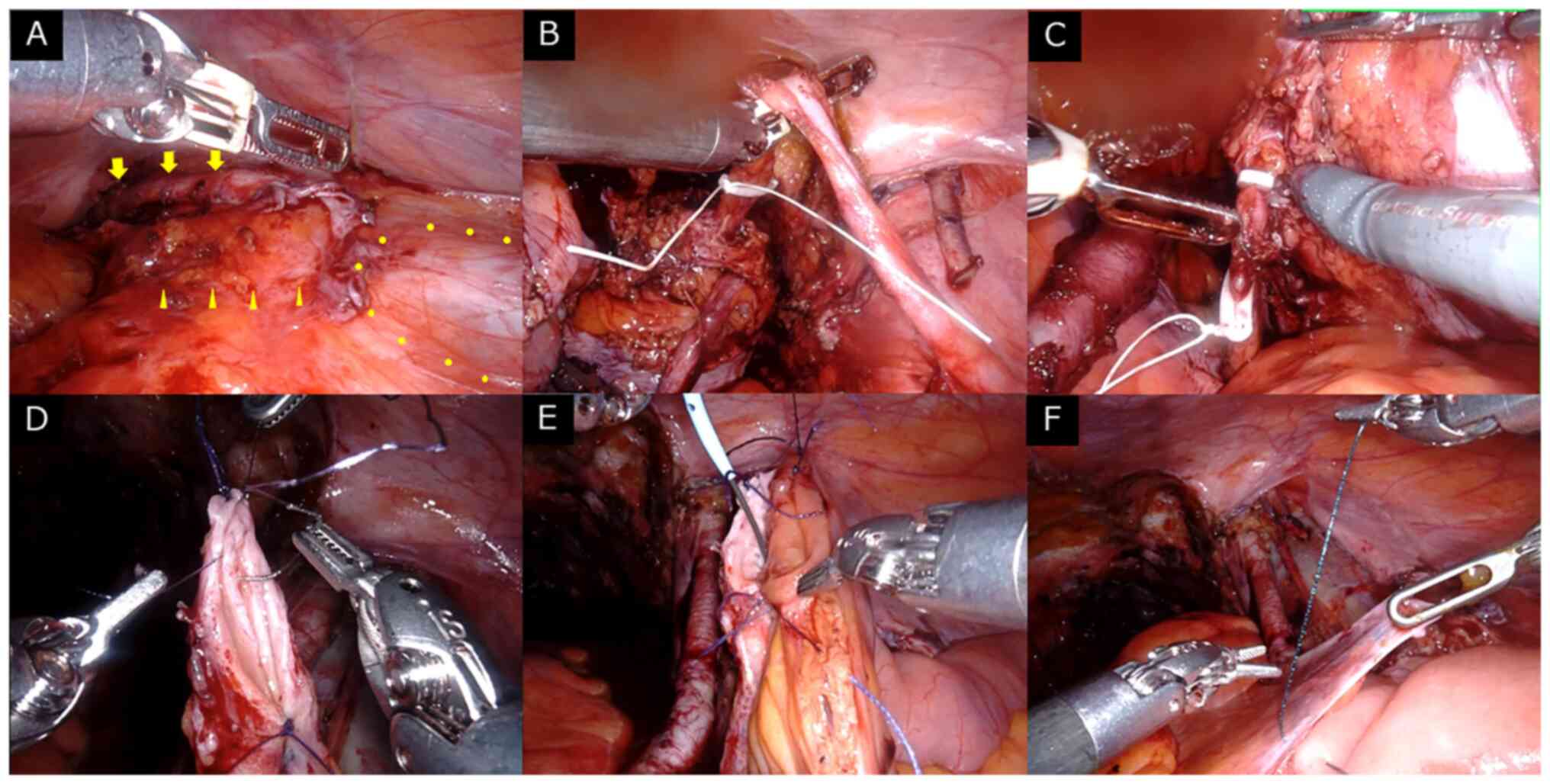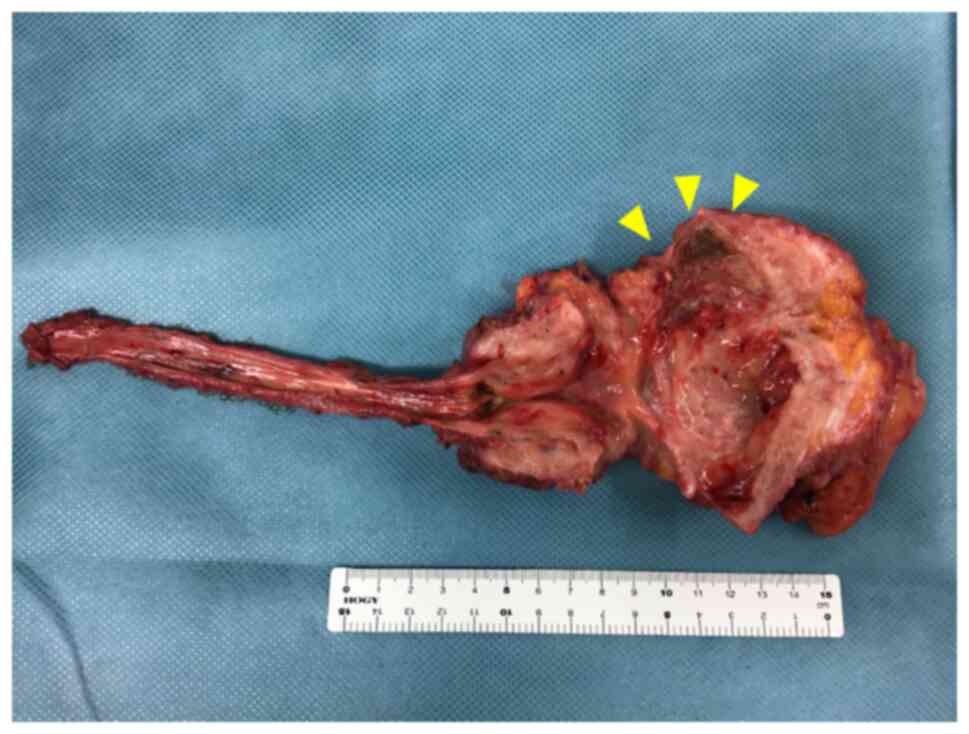Feasibility of robot‑assisted radical cystectomy in a patient with an ectopic kidney: A case report
- Authors:
- Published online on: November 29, 2022 https://doi.org/10.3892/mi.2022.61
- Article Number: 1
-
Copyright: © Edamura et al. This is an open access article distributed under the terms of Creative Commons Attribution License.
Abstract
Introduction
An ectopic kidney is a condition in which the kidney does not migrate to its normal position during fetal development and remains in the pelvis. The incidence of renal ectopy ranges from 2-10 per 10,000 individuals, depending on the method of detection (autopsy, prenatal ultrasound, or screening ultrasound) (1,2). The number of muscle-invasive bladder cancers (MIBCs) requiring total cystectomy is increasing. The co-existence of ectopic kidneys with bladder cancer further complicates the surgical procedure and it thus becomes problematic (3-5). Robot-assisted radical cystectomy (RARC) has expanded from the purely laparoscopic approach and is steadily gaining popularity among urologists. Robotic technology can improve procedural certainty and safety by aiding complex laparoscopic procedures with three-dimensional visualization and wrist-jointed instruments that facilitate suturing within the body cavity. There are reports of open total cystectomy in patients with ectopic kidneys (3-5); however, to date, at least to the best of our knowledge, no cases have been reported involving a RARC.
The present study, through the description of the case of an affected patient, demonstrates that RARC with intracorporeal urinary diversion (ICUD) for patients with an ectopic kidney is a feasible and safe procedure.
Case report
A 72-year-old male patient presented to Okayama University Hospital (Okayama, Japan) for a medical check-up. He had a history of cigarette smoking, but no significant medical history and or prior surgery, medication, or exposure to industrial chemicals. His physical and clinical examination revealed normal signs. A urinalysis revealed microscopic hematuria (urinary red blood cell count, 10-19/hpf) and the urine cytology was class V.
Magnetic resonance imaging revealed a MIBC on the right wall of the bladder, which was confirmed by cystoscopy (Fig. 1). A transurethral resection of the bladder tumor (TUR-BT) was performed. The pathological examination revealed invasive urothelial carcinoma with a micropapillary pattern (at least pT2, high grade). A contrast-enhanced computed tomography (CT) scan of the chest, abdomen, and pelvic region revealed no obvious metastatic lesions; however, an ectopic left kidney was identified in the upper pelvis opposite the L4 vertebral body. The ectopic kidney did not fuse with the contralateral kidney and the ureter of the ectopic kidney maintains its normal insertion into the bladder (Fig. 2). It was thus decided that an immediate total cystectomy without neoadjuvant chemotherapy be performed, based on the pathological results.
After placing the surgical port in the usual position, the robot-assisted operation was commenced in the head-down position. The right ureter was dissected and secured as usual (Fig. 3A and B). Although the left displaced ureter was difficult to dissect due to dense adhesions to the surrounding tissues, the dissection and securing of the ureter based on a thorough pre-operative review, was successfully achieved (Fig. 3C). As the left ectopic kidney remained in a relatively high position, a total cystectomy and extended lymph node dissection without the retraction of the kidney were able to be performed. The left ureter was of sufficient length, and a standard ileal stoma was created with a uretero-ileal anastomosis using the Wallace method in the ICUD (Fig. 3D-F) (6). The insufflation time was 8 h and 9 min, the operative time was 9 h and 4 min, with a blood loss of 300 ml. The drainage tube was removed on the fourth post-operative day, and the ureteral stent on the seventh postoperative days. The patient had a good post-operative course and was discharged on the 13th post-operative day. Upon further follow-up, the histopathological diagnosis of the resected specimen revealed that this was an invasive urothelial carcinoma, high-grade, pT2aN0Mx tumor with negative surgical margins (Fig. 4). A CT scan was obtained at 2 months post-surgery, which revealed no obvious cancer recurrence or metastasis, and no evidence of hydronephrosis (Fig. 5). The patient is currently under observation without post-operative adjuvant chemotherapy.
Discussion
Robotic surgery is well-established in the field of urologic surgery and is considered the gold standard for total cystectomy. In the present study, RARC with ICUD were performed for MIBC complicated by an ectopic kidney. To the best of our knowledge, this is the first reported case using a robot for this surgery. Ectopic kidneys have fundamentally difficult characteristics, including a short ureter, altered vascularity and pelvic anatomy, during urinary diversion surgery. In the case presented herein, the left ectopic kidney remained relatively elevated, allowing for a total cystectomy and extended lymph node dissection without retracting the kidney. Although there was no typical difficulty, it was difficult to dissect and assess the left ectopic ureter that was tightly adherent to the surrounding tissue; however, there were no congenital malformation complications, such as vesicoureteral reflux or ureteral stricture, and no history of urinary stones or urinary tract infections. As in the case in the present study, ectopic adhesions of the kidney or ureter to surrounding tissues in ectopic kidney cases may exist. Of note, a previous study demonstrated that the isolation of the pelvis was difficult due to dense adhesions in an ectopic kidney with ureteropelvic junction obstruction (7).
ICUD has been shown to be useful in cases with renal malformations. A shortened ureter length is another characteristic of pelvic kidneys, which may be an obstacle to complete ureterocutaneostomy. Considering the intraoperative mobilization and surgical invasiveness, an ICUD is more suitable than an extracorporeal urinary diversion (ECUD) for tension-free anastomosis of the ureter in the presence of a pelvic kidney. Although the option of orthotopic ileum-neobladder is theoretically possible, no such case has yet been reported. The usefulness of robotic surgery for other diseases with ectopic kidneys has been reported elsewhere related to the treatment of malignant tumors of the kidney (8), renal pelvis (9) and prostate (10), as well as urinary tract stones (11), suggesting that robotic surgery may have additional utility in other abdominal and pelvic surgeries.
In conclusion, to the best of our knowledge, the present study describes the first case of RARC with ICUD for MIBC complicated by an ectopic kidney, in which a favorable outcome was obtained. As experience accumulates involving renal malformations with robotic surgery, surgeons will be able to complete more complex resections.
Acknowledgements
Not applicable.
Funding
Funding: No funding was received.
Availability of data and materials
The datasets used and/or analyzed during the current study are available from the corresponding author on reasonable request.
Authors' contributions
KE and TS wrote the manuscript. JH, TI SH and WA performed the examination of the patient. KE, TS, TI, SH, KN, YK and MA participated in deciding on the treatment plan for the patient. JH, TI, SH and MA critically revised the manuscript for intellectual content. KE and TS confirm the authenticity of all the raw data. The final version of the manuscript has been read and approved by all authors.
Ethics approval and consent to participate
Written informed consent was obtained from the patient for this participation in the present study.
Patient consent for publications
Written informed consent was obtained from the patient for the publication of the present case report and any accompanying images.
Competing interests
The authors declare that they have no competing interests.
References
|
Yuksl A and Batukan C: Sonographic findings of fetuses with an empty renal fossa and normal amniotic fluid volume. Fetal Diagn Ther. 19:525–532. 2004.PubMed/NCBI View Article : Google Scholar | |
|
Sheih CP, Liu MB, Hung CS, Yang KH, Chen WY and Lin CY: Renal abnormalities in schoolchildren. Pediatrics. 84:1086–1090. 1989.PubMed/NCBI | |
|
Vaughn W, Hickey D, Milam WH and Soloway M: Radical cystectomy in presence of fused ‘cake’ kidney. Urology. 29:552–554. 1987.PubMed/NCBI View Article : Google Scholar | |
|
Quek ML, Basrawala Z, McClung C and Flanigan RC: Radical cystectomy with extended lymphadenectomy in the presence of a pelvic kidney. Urology. 68:672.e21–e22. 2006.PubMed/NCBI View Article : Google Scholar | |
|
Adamakis I, Pournaras C, Katafigiotis I, Kousournas G, Fragkiadis E, Leotsakos I, Alamanis C, Mitropoulos D and Constantinides C: Radical cystectomy and lymphadenectomy to two patients with pelvic kidney: Surgical pitfalls and considerations. Case Rep Med. 2013(841806)2013.PubMed/NCBI View Article : Google Scholar | |
|
Wallace DM: Ureteric diversion using a conduit: A simplified technique. Br J Urol. 38:522–527. 1966.PubMed/NCBI View Article : Google Scholar | |
|
Simone G, Leonardo C, Papalia R, Guaglianone S, Sacco R, Forastiere E and Gallucci M: Case report: Laparoscopic ureteral reconstruction with pelvic flap in ureteropelvic junction obstruction of ectopic left kidney. J Endourol. 21:1041–1043. 2007.PubMed/NCBI View Article : Google Scholar | |
|
Kumar S, Singh S, Jain S, Bora GS and Singh SK: Robot-assisted heminephrectomy for chromophobe renal cell carcinoma in L-shaped fused crossed ectopia: Surgical challenge. Korean J Urol. 56:729–732. 2015.PubMed/NCBI View Article : Google Scholar | |
|
Rezaee ME, Shetty Z, Pridmore D, Dave CN and Shetty SD: Robot-assisted laparoscopic nephroureterectomy for transitional cell carcinoma of a right pelvic kidney. J Endourol Case Rep. 2:131–134. 2016.PubMed/NCBI View Article : Google Scholar | |
|
Boczko J and Joseph JV: Robot-assisted extraperitoneal radical prostatectomy in a patient with a pelvic kidney. Urology. 68:1122.e3–e4. 2006.PubMed/NCBI View Article : Google Scholar | |
|
Kerr PS, Nguyen NT, Martinez A, Srinivasan A, Kosarek CD and Sreshta JN: Robotic pyelolithotomy in a solitary pelvic kidney complicated with fulminant Clostridium difficile: A case report. J Med Case Rep. 16(126)2022.PubMed/NCBI View Article : Google Scholar |













